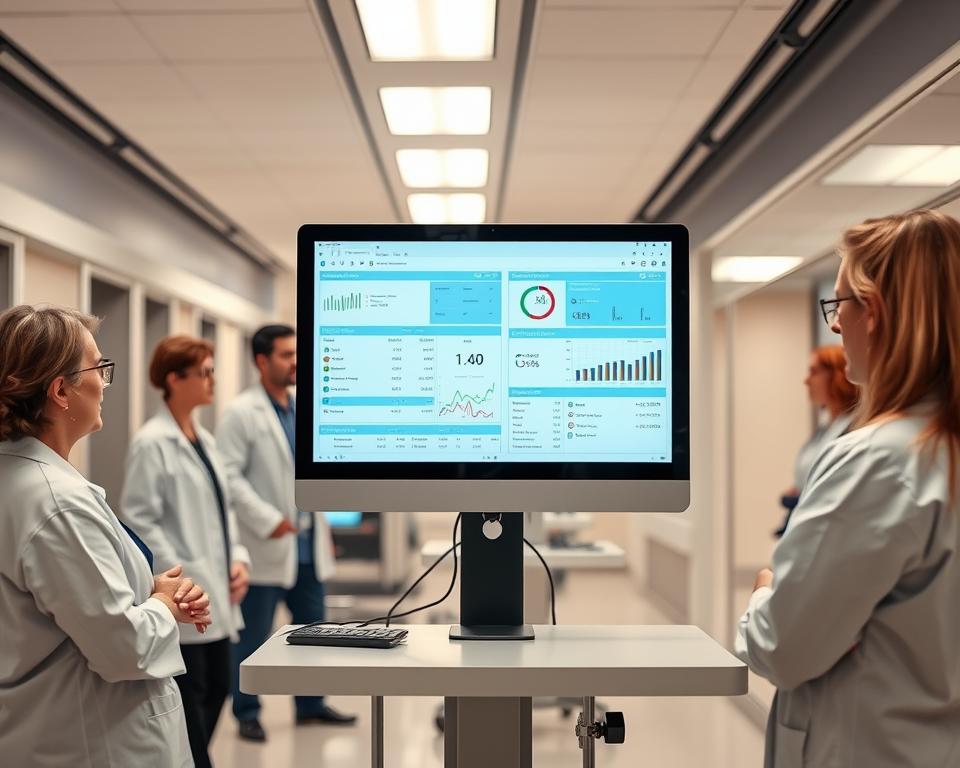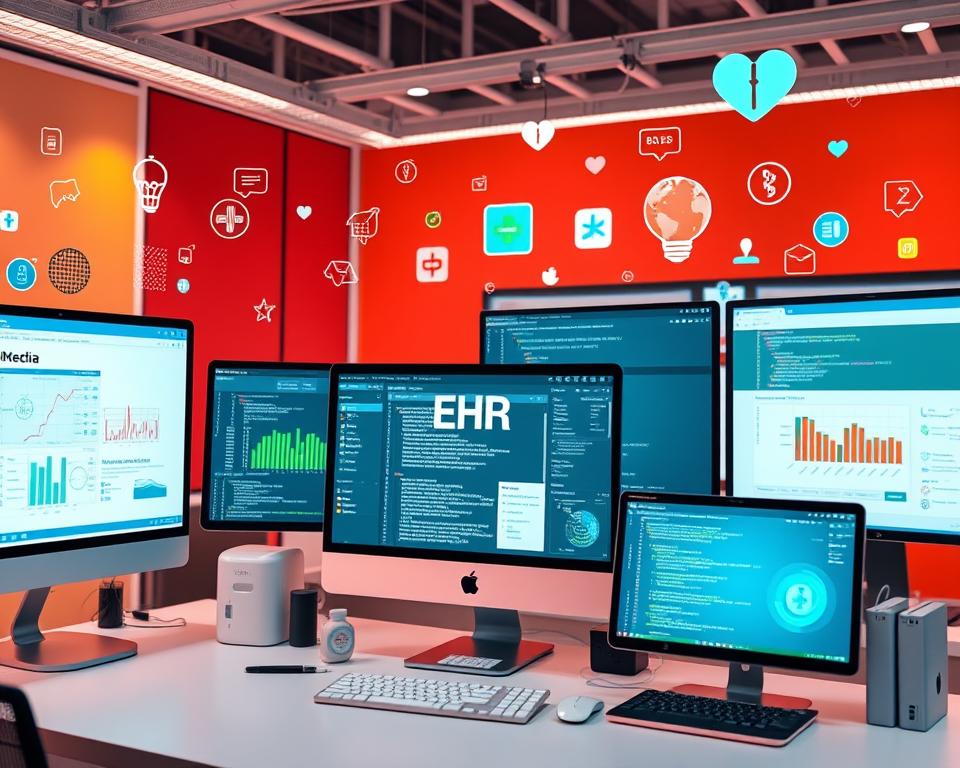The healthcare industry is seeing a big shift towards electronic health records (EHR) software. More and more hospitals and doctor’s offices are using EHR systems. This is because over 95% of hospitals and 80% of doctor’s offices now use certified EHR technology.
This growth means there’s a big need for healthcare software that works well. This includes systems for medical billing.
Creating EHR software is a big task. It needs to think about how doctors work, how patients are involved, and follow the rules. The goal is to make a system that helps with paperwork, writing prescriptions, and scheduling. It also has to keep patient data safe and sound.
By understanding how to make EHR software, healthcare providers can help patients more. They can also save money.
Table of Contents
Key Takeaways
- Electronic health records (EHR) software development is a critical aspect of the healthcare industry
- The adoption of EHR systems has increased significantly, with over 95% of hospitals and 80% of physician practices using certified EHR technology
- Healthcare software, including medical billing systems, must be robust and user-friendly
- Clinical workflow, patient engagement, and regulatory compliance are key considerations in EHR software development
- Comprehensive EHR systems can improve patient care and reduce costs
- EHR software development requires careful planning and execution to ensure security and integrity of patient data
Understanding Electronic Health Records (EHR) Systems
EHR systems aim to make healthcare better by giving doctors the latest patient info. The Centers for Medicare and Medicaid Services (CMS) says EHRs are “electronic systems that store, manage, and provide access to patient health information.” This shows how crucial EHRs are in today’s healthcare.
EHR systems have practice management and patient engagement tools. They also offer clinical decision support to help doctors make better choices for patients.
What is EHR Software?
EHR software is a digital system for storing and managing patient health info. It helps improve healthcare by giving doctors the latest patient data.
Key Components of EHR Systems
Some main parts of EHR systems are:
- Electronic patient records
- Clinical decision support tools
- Practice management systems
- Patient engagement platforms
Benefits of Custom EHR Solutions
Custom EHR solutions fit the needs of healthcare groups, boosting support and engagement. They give doctors the latest patient info. This helps make healthcare better and more efficient.
The Current State of EHR Software Development
The world of EHR software development is complex. Healthcare organizations face many challenges. One big issue is the lack of interoperability between different EHR systems. This makes health information exchange hard and limits the benefits of healthcare software.
A report by the Healthcare Information and Management Systems Society (HIMSS) shows how crucial interoperability is. It points out that interoperability is a big problem for healthcare groups. They need seamless health information exchange to better care for patients.
Some major hurdles in EHR software development include:
- Lack of standardization in EHR systems
- Insufficient interoperability between different EHR systems
- High development and implementation costs of healthcare software
Even with these challenges, EHR software development keeps moving forward. There’s a growing focus on interoperability and health information exchange. As healthcare moves towards more integrated care, the need for healthcare software that supports interoperability and health information exchange will grow.
| Challenge | Description |
|---|---|
| Lack of standardization | Difficulty in exchanging health information between different EHR systems |
| Insufficient interoperability | Limited ability to share patient data between healthcare providers |
| High development costs | Financial burden on healthcare organizations to develop and implement EHR software |
Essential Features for Modern EHR Software
Modern electronic health records (EHR) software should have key features. These help streamline clinical work, improve patient care, and manage practices better. The American Medical Association (AMA) suggests features like managing patient info, clinical notes, and e-prescribing.
Patient Information Management
This feature lets healthcare providers manage patient data. It includes medical history, test results, and medications. Good patient info management is key for quality care and smooth billing and practice management.
Clinical Documentation
Clinical documentation is vital in EHR software. It helps providers create, edit, and manage clinical documents. This includes progress notes, discharge summaries, and medication lists. Accurate and efficient documentation is crucial for care continuity and error reduction.
E-Prescribing Capabilities
E-prescribing lets providers send prescriptions to pharmacies electronically. It reduces errors and boosts patient safety. This feature is important for practice management, making the prescribing process smoother and safer.
Scheduling and Administrative Tools
Scheduling and administrative tools are also key in EHR software. They help manage appointments, schedules, and billing. This makes it easier for providers to run their practices and focus on patient care.
Technical Requirements for Building EHR Software
When making healthcare software, it’s key to think about the tech needs. These ensure interoperability, security, and can grow with more users. The Office of the National Coordinator for Health Information Technology (ONC) helps with these needs. They suggest using standard APIs and data exchange protocols.
Building EHR software also means focusing on medical billing. This part needs to work well with other systems. Developers must make software that shares data safely and smoothly. This is where interoperability helps, letting different healthcare systems talk and share patient info.
- Standardized APIs for data exchange
- Secure authentication and authorization protocols
- Scalable architecture to support growing patient data
Meeting these tech needs helps developers make healthcare software. It makes clinical work easier, improves patient care, and cuts costs in medical billing.
Regulatory Compliance and Standards
When making EHR software, it’s key to think about rules and standards. The Health Insurance Portability and Accountability Act (HIPAA) has rules for keeping patient health info safe. Following HIPAA is vital for keeping patient data secure and trustworthy.
Health information exchange and interoperability are also big deals in EHR software making. Being able to share health info between different EHR systems is crucial for top-notch patient care.
Key Regulatory Requirements
- HIPAA compliance requirements: ensuring the confidentiality, integrity, and availability of patient health information
- HL7 integration standards: facilitating the exchange of health information between different EHR systems
- FHIR implementation guidelines: enabling the secure and standardized exchange of health information
By sticking to these rules and standards, EHR software makers can make sure health info is shared safely and well. This helps improve patient care and results.
| Regulatory Requirement | Description |
|---|---|
| HIPAA Compliance | Protecting sensitive patient health information |
| HL7 Integration | Facilitating health information exchange between EHR systems |
| FHIR Implementation | Enabling secure and standardized health information exchange |
EHR Software Development: Step-by-Step Process
Creating EHR software takes several steps. Each step is important to make a system that healthcare groups need. The Software Development Life Cycle (SDLC) guides the making of software, like EHR systems. These systems work with healthcare software and medical billing systems.
The first step is planning. Here, needs are gathered and a project plan is made. Then, the design phase comes. It’s where the system’s look and feel are planned.
The development phase is next. This is when the coding happens. The system must work well with practice management systems.
Planning Phase
In this phase, the team gets requirements from stakeholders. They make a project plan. This plan shows the project’s scope, timeline, and budget.
Design Phase
The design phase is about making a detailed plan for the system. This includes the user interface and system architecture. It’s key to make sure the system fits healthcare needs and works with other systems.
Development Phase
The development phase is when the coding happens. It needs careful planning and execution. This ensures the system is made on time and within budget.
Testing Phase
The testing phase checks if the system meets the requirements and is bug-free. It’s crucial for making sure the system is reliable and safe.
Security Measures in EHR Software Development
Creating electronic health records (EHR) software needs careful security planning. The National Institute of Standards and Technology (NIST) offers guidelines. These include using encryption, access controls, and audit trails.
Some important security steps for EHR software are:
- Encrypting patient data, both in transit and at rest
- Using access controls like passwords and roles
- Keeping audit trails for all system actions
- Updating security regularly to fix vulnerabilities
Healthcare software makers must focus on security. This ensures patient records stay safe and reliable. By following guidelines and using strong security, developers help keep patient data safe.
Security in EHR software development is key to avoiding data breaches. It keeps patient health info safe. Healthcare groups can protect their patients’ data and follow rules by using strong security.
Database Architecture and Management
Building a good database is key for healthcare software, especially for electronic health records (EHR) systems. A well-made database makes EHR systems scalable, secure, and fast. This is vital for handling lots of patient health info.
Relational databases and data warehousing help store and manage patient health info, including medical billing data. This lets healthcare providers quickly access and analyze patient data. This is crucial for giving top-notch care.
Data Models and Structure
A strong data model is vital for managing databases in healthcare software. It’s about creating a structure that can hold different types of patient data. This includes things like demographics, medical history, and treatment plans.
Storage Solutions
Storage solutions for healthcare software need to be safe, growable, and dependable. Cloud-based storage solutions can offer flexibility and easy access.
Backup Systems
Backup systems are key to keeping patient data safe and available. Regular backups and disaster recovery plans help avoid data loss. They also ensure care can keep going even if there’s a system failure.
By focusing on good database architecture and management, healthcare software developers can make strong and dependable EHR systems. These systems are crucial for delivering quality patient care. This is especially true for medical billing, where managing data well is key for managing revenue cycles.
Integration Capabilities and APIs
Effective interoperability is key for smooth health information sharing between systems. This is done through standardized APIs and data exchange protocols. These tools help EHR systems work well with other healthcare apps, improving patient care.
APIs make it safe and easy to share health data. This helps different systems talk to each other. For example, EHR systems can connect with lab and radiology systems. This way, healthcare providers can share information securely, leading to better patient care.
- It makes it easier for different healthcare systems to work together.
- It helps in better patient care and outcomes by sharing health information safely and efficiently.
- It makes healthcare providers more efficient and productive.
User Interface Design for EHR Systems
The design of the user interface is key to how well electronic health records (EHR) systems work. A good design makes it easier for healthcare providers to manage patient info and care for patients. It’s important for the success of healthcare software.
A great user interface should make it easy for healthcare providers to use the system. It should help them quickly find patient info and reduce time on paperwork. It’s also important to make sure the system is accessible to everyone, including those with disabilities.
Clinical Workflow Optimization
- Streamline clinical workflows to reduce administrative burdens
- Implement intuitive navigation and search functionality
- Provide real-time access to patient information and medical history
Accessibility Guidelines
- Follow Web Content Accessibility Guidelines (WCAG 2.1)
- Ensure compatibility with assistive technologies
- Provide alternative text for images and graphics
By focusing on user interface design and experience, healthcare groups can make their EHR systems better. This leads to better patient care and outcomes. As EHRs and healthcare software grow, it’s crucial to keep the user at the center of design.
Testing and Quality Assurance
Healthcare software, especially electronic health records (EHR) systems, needs quality assurance to meet standards. This ensures the software works well, is secure, and easy to use. Testing and quality assurance help find and fix problems before the software is used.
In medical billing, quality assurance is key to avoid errors. These errors could cause financial losses or harm patient care. Strong testing and quality assurance help healthcare software developers make reliable and high-quality products.
Important parts of testing and quality assurance for healthcare software include:
- Functional testing to make sure the software works right
- Security testing to find and fix any weak spots
- Usability testing to make sure the software is easy to use
By focusing on testing and quality assurance, developers can make top-notch software. This software meets healthcare professionals’ and patients’ needs. It also follows rules and standards for healthcare software and medical billing.
Implementation and Deployment Strategies
Implementing and deploying healthcare software needs a solid plan. This includes training staff, moving data, and planning the go-live date. A smooth transition to the new system is key. For example, good medical billing systems make healthcare services more efficient.
The process of implementing healthcare software is complex. It involves integrating with current systems, ensuring data security, and making sure users are happy. Knowing the strengths and weaknesses of the current system is crucial. Healthcare software developers and implementers play a big role here. They make sure the new system fits the healthcare organization’s needs.
- Staff training: Providing comprehensive training to staff members to ensure they are comfortable using the new system.
- Data migration: Transferring existing data to the new system, ensuring accuracy and completeness.
- Go-live planning: Coordinating the launch of the new system, including testing and quality assurance.
By focusing on these areas and teaming up with healthcare software developers, organizations can make the new system work well. This leads to better patient care and easier medical billing.
Maintenance and Support Requirements
Regular maintenance is key for keeping healthcare software running smoothly. This includes updates, troubleshooting, and technical support. It helps fix any problems that come up.
Maintenance and support are very important. They make healthcare software reliable and easy to use. Regular upkeep helps avoid downtime, cuts down on mistakes, and boosts patient care. Some main parts of maintenance and support are:
- Software updates and patches to meet rules
- Troubleshooting and technical support to solve problems fast
- Checking how well the software works to find ways to get better
- Keeping patient data safe from hackers
Good maintenance and support need teamwork. Healthcare groups, software makers, and IT experts must work together. This way, healthcare software, like medical billing systems, stays up to date.
Putting maintenance and support first helps healthcare software work better. It makes things more efficient, saves money, and improves care. Keeping software well-maintained is crucial for its long-term success. It’s something every healthcare organization should think about when using or updating EHR or medical billing systems.
Cost Considerations and ROI Analysis
Creating and using Electronic Health Record (EHR) systems can cost a lot. But, they can also save a lot by making things more efficient and cutting costs. EHR systems help make healthcare work better by reducing manual work and mistakes.
When looking at the cost of EHR software, remember to include development costs. This includes the cost of hardware, software, and people. Also, think about operational expenses like upkeep, support, and training. A detailed cost analysis helps understand the financial side of EHR software.
Some big advantages of EHR systems are:
- They help improve patient care with better clinical support
- They make work more efficient and productive with automated tasks
- They cut costs by reducing mistakes and using resources better
- They make medical billing and managing money flow easier
Investing in EHR software can lead to big benefits. Healthcare places can see better patient care, more efficiency, and lower costs. A good cost analysis and ROI check can guide decisions on EHR software.
Conclusion
The use of electronic health records (EHR) systems changes healthcare a lot. They help improve patient care, cut costs, and make healthcare better. EHR software is key in the healthcare world.
Creating and using EHR systems well needs careful thought. We must think about how they fit into clinical work, patient involvement, and following rules.
Healthcare software, like EHR systems, must fit the needs of doctors and patients. It must keep patient data safe and help with quick and accurate medical notes and prescriptions. This way, healthcare places can work better, help patients more, and save money.
In short, EHR software development and use are very important. As healthcare keeps changing, the need for good EHR systems will grow. By focusing on these systems, healthcare places can better care for patients, save money, and improve healthcare quality.



















